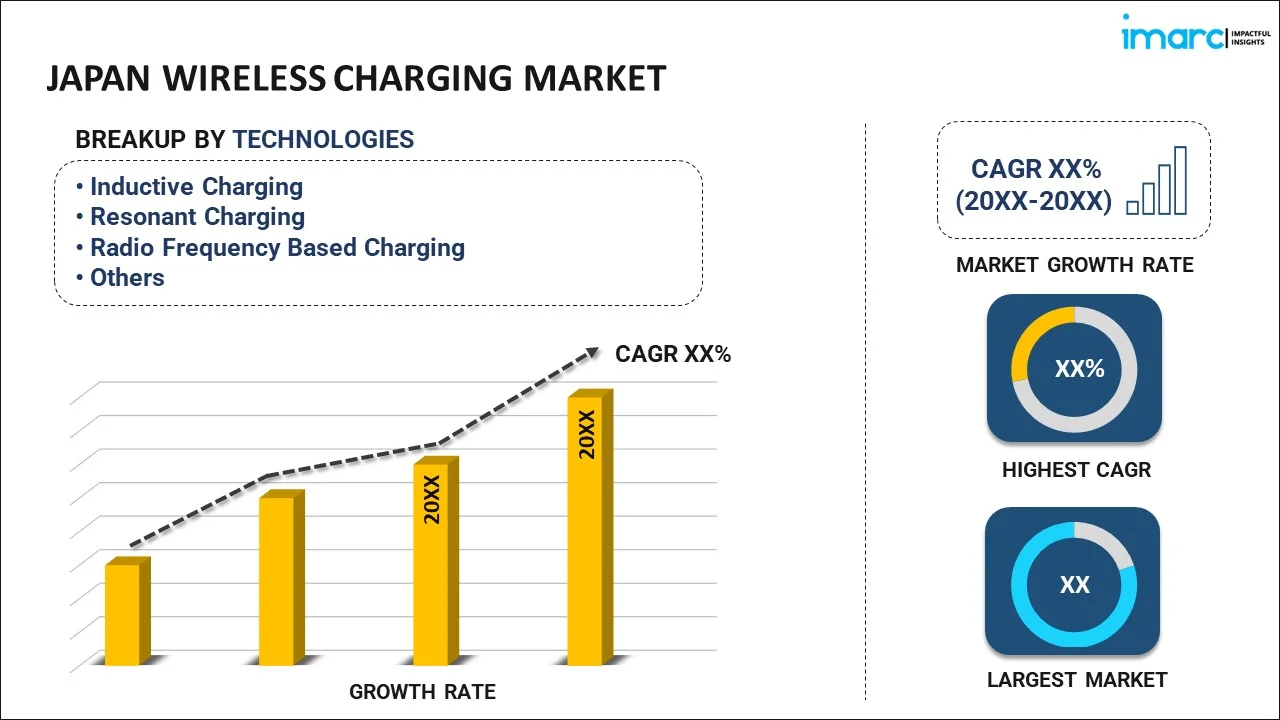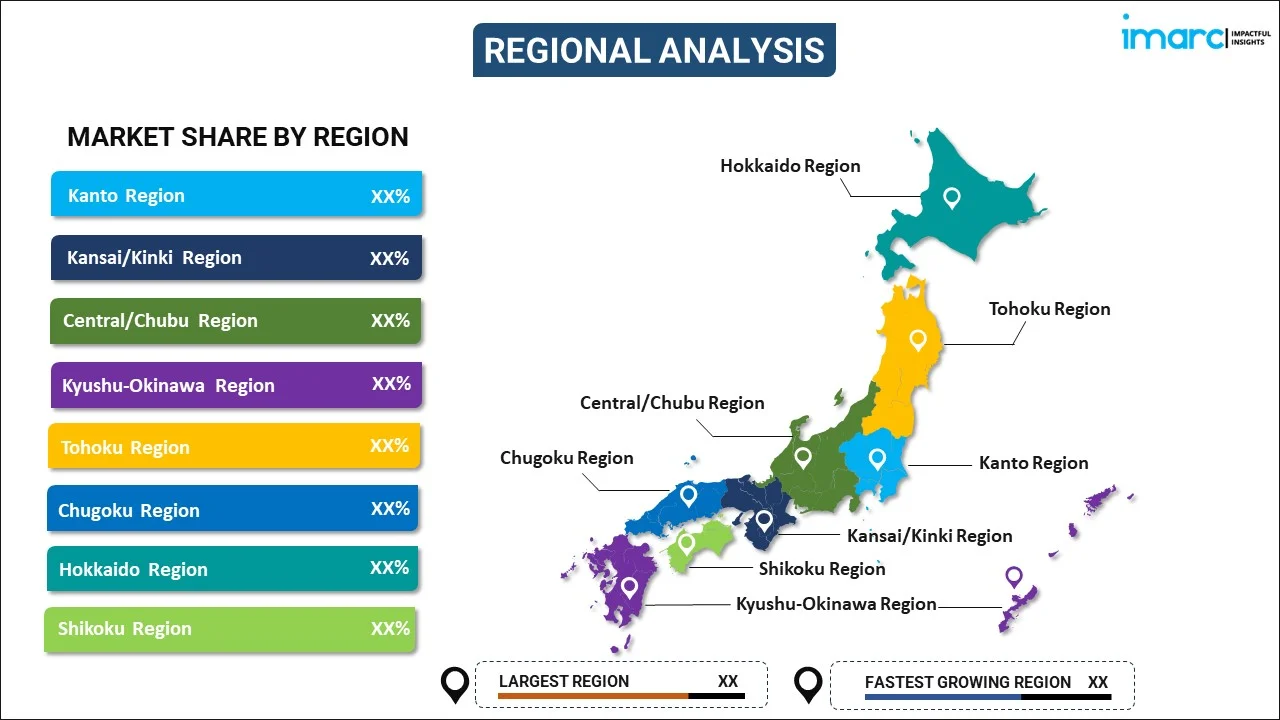
Japan Wireless Charging Market Report by Technology (Inductive Charging, Resonant Charging, Radio Frequency Based Charging, and Others), Transmission Range (Short Range, Medium Range, Long Range), Application (Consumer Electronics, Automotive, Healthcare, Industrial, Defense, and Others), and Region 2025-2033
Market Overview:
Japan wireless charging market size reached USD 1,177 Million in 2024. Looking forward, IMARC Group expects the market to reach USD 10,784 Million by 2033, exhibiting a growth rate (CAGR) of 27.9% during 2025-2033. The increasing demand for wireless charging stations in public spaces, such as airports, coffee shops, hotels, etc., that encourages users to adopt wireless charging technology, is primarily driving the market.
|
Report Attribute
|
Key Statistics
|
|---|---|
|
Base Year
|
2024
|
|
Forecast Years
|
2025-2033
|
|
Historical Years
|
2019-2024
|
|
Market Size in 2024
|
USD 1,177 Million |
|
Market Forecast in 2033
|
USD 10,784 Million |
| Market Growth Rate 2025-2033 | 27.9% |
Wireless charging is a convenient and innovative technology that enables the transfer of electrical power to electronic devices without the need for physical cables or connectors. It relies on electromagnetic fields to transmit energy from a charging pad or base station to a compatible device, such as a smartphone or wearable gadget. The process involves two main components: a transmitter (the charging pad) and a receiver (the device being charged). The transmitter generates an alternating current, which creates an electromagnetic field around it. When the receiver (often embedded in the device's back cover or case) comes into close proximity with the transmitter, it converts the electromagnetic energy back into electrical power, which charges the device's battery. Wireless charging offers several advantages, including the elimination of tangled cords, ease of use, and the potential for waterproof and dustproof designs. It is a promising technology that is gaining popularity in various consumer electronics and automotive applications.
Japan Wireless Charging Market Trends:
The wireless charging market in Japan has witnessed remarkable growth in recent years, driven primarily by several key factors. To begin with, the proliferation of smartphones and other portable electronic devices has created a burgeoning demand for wireless charging solutions. As consumers increasingly seek convenience and efficiency, the need for a cable-free charging experience becomes paramount. Moreover, the growing awareness of environmental sustainability and the reduction of electronic waste have played a significant role in propelling the wireless charging market forward. With the elimination of disposable charging cables and the reduction in electronic waste, wireless charging aligns well with eco-conscious consumer preferences. Furthermore, the ongoing development of electric vehicles (EVs) has added another dimension to the market's expansion. Wireless charging offers a seamless and user-friendly approach to recharging EVs, fostering the transition to electric mobility. In addition to this, technological advancements, such as improved charging speeds and greater compatibility across devices, which have enhanced the appeal of wireless charging solutions, are expected to drive the market in Japan during the forecast period.
Japan Wireless Charging Market Segmentation:
IMARC Group provides an analysis of the key trends in each segment of the market, along with forecasts at the country level for 2025-2033. Our report has categorized the market based on technology, transmission range, and application.
Technology Insights:

- Inductive Charging
- Resonant Charging
- Radio Frequency Based Charging
- Others
The report has provided a detailed breakup and analysis of the market based on the technology. This includes inductive charging, resonant charging, radio frequency based charging, and others.
Transmission Range Insights:
- Short Range
- Medium Range
- Long Range
A detailed breakup and analysis of the market based on the transmission range have also been provided in the report. This includes short range, medium range, and long range.
Application Insights:
- Consumer Electronics
- Automotive
- Healthcare
- Industrial
- Defense
- Others
The report has provided a detailed breakup and analysis of the market based on the application. This includes consumer electronics, automotive, healthcare, industrial, defense, and others.
Regional Insights:

- Kanto Region
- Kansai/Kinki Region
- Central/ Chubu Region
- Kyushu-Okinawa Region
- Tohoku Region
- Chugoku Region
- Hokkaido Region
- Shikoku Region
The report has also provided a comprehensive analysis of all the major regional markets, which include Kanto Region, Kansai/Kinki Region, Central/ Chubu Region, Kyushu-Okinawa Region, Tohoku Region, Chugoku Region, Hokkaido Region, and Shikoku Region.
Competitive Landscape:
The market research report has also provided a comprehensive analysis of the competitive landscape in the market. Competitive analysis such as market structure, key player positioning, top winning strategies, competitive dashboard, and company evaluation quadrant has been covered in the report. Also, detailed profiles of all major companies have been provided.
Japan Wireless Charging Market Report Coverage:
| Report Features | Details |
|---|---|
| Base Year of the Analysis | 2024 |
| Historical Period | 2019-2024 |
| Forecast Period | 2025-2033 |
| Units | Million USD |
| Scope of the Report | Exploration of Historical and Forecast Trends, Industry Catalysts and Challenges, Segment-Wise Historical and Predictive Market Assessment:
|
| Technologies Covered | Inductive Charging, Resonant Charging, Radio Frequency Based Charging, Others |
| Transmission Ranges Covered | Short Range, Medium Range, Long Range |
| Applications Covered | Consumer Electronics, Automotive, Healthcare, Industrial, Defense, Others |
| Regions Covered | Kanto Region, Kansai/Kinki Region, Central/ Chubu Region, Kyushu-Okinawa Region, Tohoku Region, Chugoku Region, Hokkaido Region, Shikoku Region |
| Customization Scope | 10% Free Customization |
| Post-Sale Analyst Support | 10-12 Weeks |
| Delivery Format | PDF and Excel through Email (We can also provide the editable version of the report in PPT/Word format on special request) |
Key Questions Answered in This Report:
- How has the Japan wireless charging market performed so far and how will it perform in the coming years?
- What has been the impact of COVID-19 on the Japan wireless charging market?
- What is the breakup of the Japan wireless charging market on the basis of technology?
- What is the breakup of the Japan wireless charging market on the basis of transmission range?
- What is the breakup of the Japan wireless charging market on the basis of application?
- What are the various stages in the value chain of the Japan wireless charging market?
- What are the key driving factors and challenges in the Japan wireless charging?
- What is the structure of the Japan wireless charging market and who are the key players?
- What is the degree of competition in the Japan wireless charging market?
Key Benefits for Stakeholders:
- IMARC’s industry report offers a comprehensive quantitative analysis of various market segments, historical and current market trends, market forecasts, and dynamics of the Japan wireless charging market from 2019-2033.
- The research report provides the latest information on the market drivers, challenges, and opportunities in the Japan wireless charging market.
- Porter's five forces analysis assist stakeholders in assessing the impact of new entrants, competitive rivalry, supplier power, buyer power, and the threat of substitution. It helps stakeholders to analyze the level of competition within the Japan wireless charging industry and its attractiveness.
- Competitive landscape allows stakeholders to understand their competitive environment and provides an insight into the current positions of key players in the market.
Need more help?
- Speak to our experienced analysts for insights on the current market scenarios.
- Include additional segments and countries to customize the report as per your requirement.
- Gain an unparalleled competitive advantage in your domain by understanding how to utilize the report and positively impacting your operations and revenue.
- For further assistance, please connect with our analysts.
 Inquire Before Buying
Inquire Before Buying
 Speak to an Analyst
Speak to an Analyst
 Request Brochure
Request Brochure
 Request Customization
Request Customization




.webp)




.webp)












